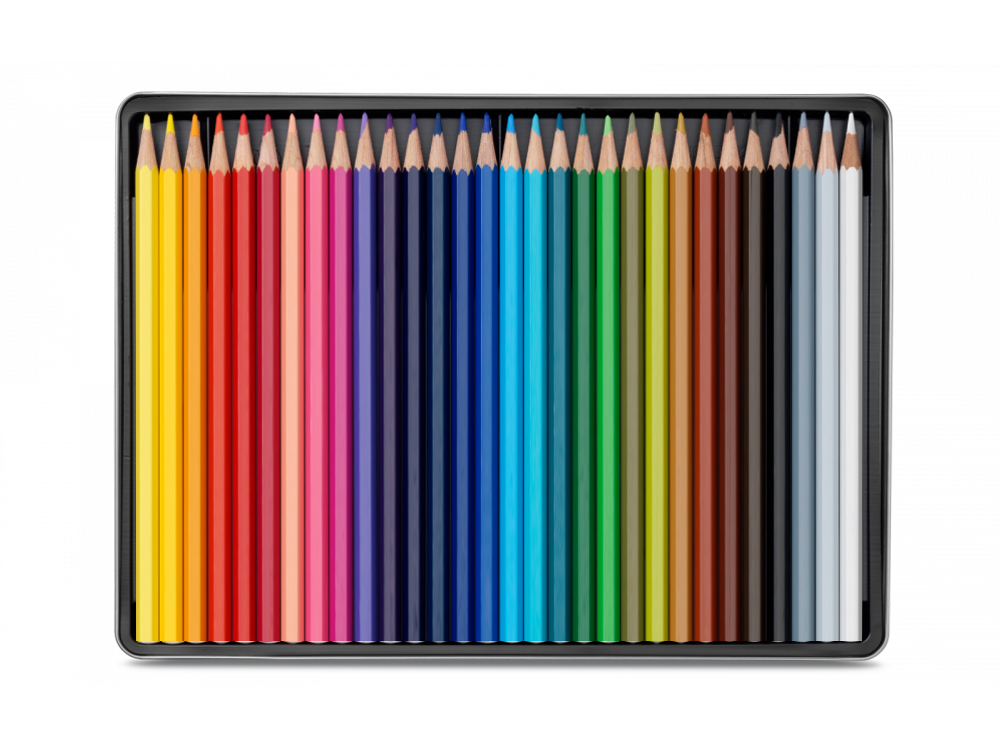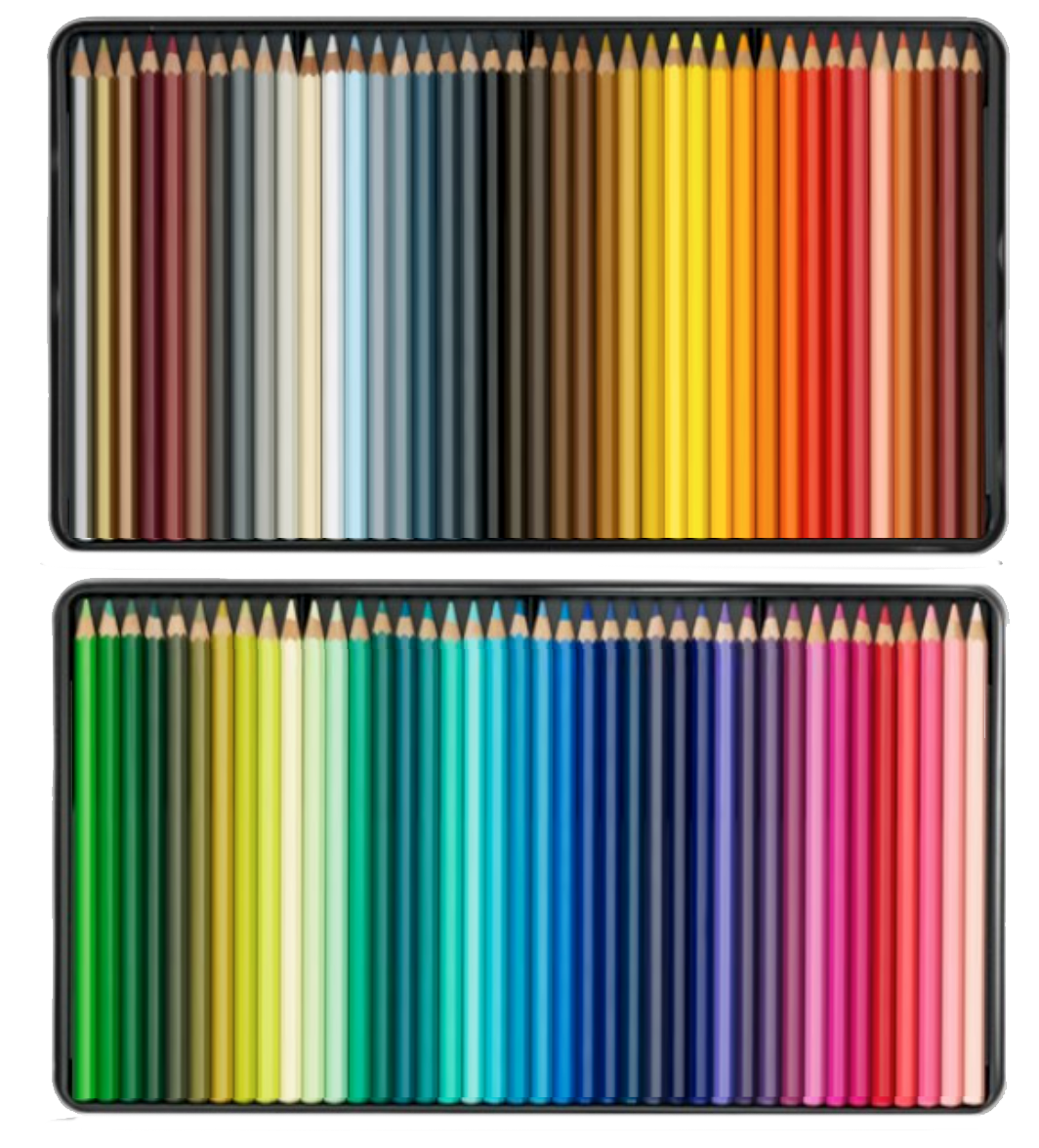Rendering Intents
Devices and gamuts
If we have two color devices we can expect differences in the ability to render colors. Different devices can have a different gamut. This is a typical situation - and most of us know that even a hi-quality monitor can display some colors that are not printable, but also a hi-quality printer can print some color samples that are impossible to be correctly displayed. Cameras, scanners, and other color rendering devices have limitations that we have to accept.
We know that different devices can have different gamuts — shape and volume of color space that are capable to render.
If you don't understand what gamut means the easiest way to imagine it is a box of crayons. Bigger set bigger gamut, but also we can imagine that one box even smaller can contain one very unique color that is hard to find in most bigger
 |
 |
The characterization data set is compiled with the readings of the measuring instrument. ChromaChecker offers profiling for CMYK and RGB printers (Print Inspector) and displays (Display Inspector). Additionally, the ICC Profile Inspector assists with the evaluation of profiles.
If we have two different devices it is pretty normal that two devices have different gamut, so whenever we want to transfer the color image from one space to another we may expect that some colors in the source color space are out of the gamut of the destination space. What to do in such a case, how we can solve it?
There is no one possible scenario of how we can transform two different spaces into another. To better understand let's imagine that we have two spaces - or source space is represented by toy and box stands for destination space.
|
|
||
| Ther is no problem if the toy is smaller than the box |
But if the toy is bigger we can
|
|
||
| cut some elements | or | compress |
Rendering Intents
Color Management Technology answer this dilemma by specifying various rendering intents
Absolute Colorimetric
The absolute colorimetric rendering intent is focused on preserving Lab coordinates. If the sample color is out of the gamut the closest possible value is applied. That means that it is very accurate for in-gamut colors at the expense of losing relationships of any samples that are out of the gamut. We can imagine situations where two noticeably different colors become identical after an Absolute Colorimetric transformation. If any detail in an image uses these colors after conversion, that detail may be lost.
Another case we have with the substrate. If for example, we have a drawing made on non-perfect white paper (which obviously does not exist in the real world) and we will try to print it on another paper that again is not perfectly white - then we will print "source white" non-perfect-white paper on "destination white". After all, there is a kind of double-reproduced paper that is perceived as darker and often judged dirtier than the original. Such color imprinting only makes sense in very specific situations and is intended for cross-rendering simulations of output conditions with another.
Relative Colorimetric
For this rendering intent, the data is recalculated to "reset" the substrate. The paper and all light samples are counted to make the paper absolutely white - that is, Lab coordinates 100/0/0. Thus, when printed on the target substrate, the new paper will change back all the light samples. If we use paper identical to the source paper, in theory, we should obtain a result identical, of course, in the range of colors inside the gamut.
Out of gamut colors are moved to the nearest point within the gamut.
Relative Colorimetric with Black Point Compensation
It is a variant of Relative Colorimetric Rendering Intent where correction is extended to Black Point. This mechanism produces better dynamics using the entire white-black ramp in a more efficient way. Thanks to native human adoption it is perceived as natural and safe rendering intent. It is recommended for most typical designer's and photographer's jobs.
Out of gamut colors are moved to the nearest point within the gamut, and for that reason is not recommended if wide-gamut images have to be rendered using a small-gamut destination device.
Perceptual
A perceptual rendering intent preserves the overall color appearance by changing all colors in the source space to fit the destination space. This method is based on nonlinear space compression. It is important to know that this method is not a subject of industrial standard and any specific solution is vendor-depended. Algorithms applied are different and the user has to judge which software offers a better result. This result depends on the gamut and color distribution of testing images
Saturation
The saturation rendering intent is useful for reproducing graphics with high color impact. It is designed to print Excel charts or PowerPoint slides in most situations created with highly saturated colors that are out of the most printer's gamut in the most "attractive" way. This rendering intent is not recommended for any professional use for designers or photographers.
| RI | Absolute | Relative | Relative w. BPC | Perceptual | Saturation |
| colorimetrical accuracy inside the gamut |
YES | Mostly yes, but not for white and bright colors | Mostly yes, but not for white and bright colors and black and dark colors | NO | NO |
| white Lab coordinates | MEASURED - ABSOLUTE VALUE | 100/0/0 (RECALCULATED) | 100/0/0 (RECALCULATED) | 100/0/0 (RECALCULATED) | — |
| black Lab coordinates | MEASURED - ABSOLUTE VALUE | MEASURED | RECALCULATED | RECALCULATED | |
| relationship between out of gamut colors |
LOST | LOST | LOST | PRESERVED | — |
| principle of method | closed possible Lab. coordinates | Similar to Absolute but with white and bright colors recalculated to eliminate substrate influence | Similar to Absolute but with white and bright colors recalculated to eliminate substrate influence, and correction to achievable black | Gamut is compressed to preserve the relationship at the expense of color accuracy | manipulation |
| purposes of usage |
Preserving Lab coordinates |
Images optimally adapted to the substrate used for the final print. | Images optimally adapted to the substrate and printable black used for the final print |
wide gamut image compressed to be printed with details in highly saturated areas of the image | print saturated colors that are typically out of the gamut |
| main areas of application |
hard proofing, printing exact color samples |
photography, art, and graphics | photography, art, and graphics |
wide-gamut photography, art, and graphics |
business presentations |
| notes | required for proofing | recommended for publication | calibrated and profiled wide-gamut monitor is strongly recommended |
Contact ChromaChecker Support
Additional information and Support Form is available for logged users.